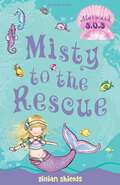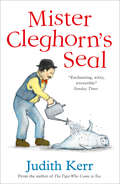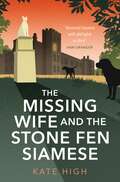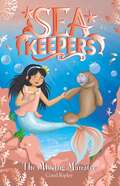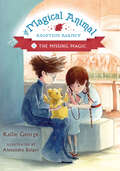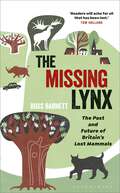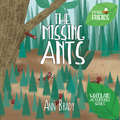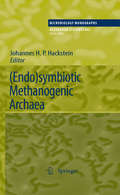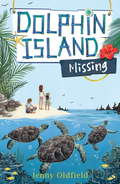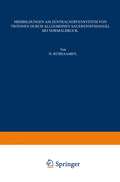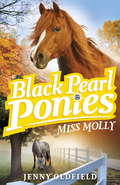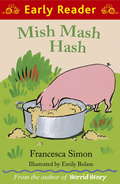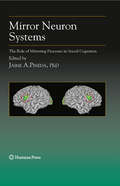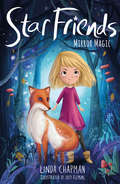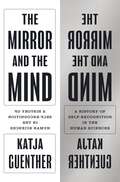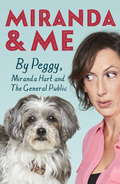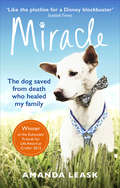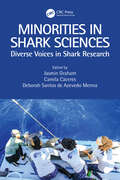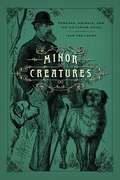- Table View
- List View
Misty to the Rescue: Mermaid SOS 1
by Gillian Shields Helen TurnerJust as Misty and her friends start to make their way back to Coral Kingdom with the magic crystals for Queen Neptuna, a storm whipped up by the evil Mantora throws them right off course!Misty and her fellow Sisters of the Sea are lost, but they must find their way home as quickly as possible in order to complete their important mission.Misty comes up with a brilliant plan to help her mermaid friends, as well as saving a forest deep in the ocean from a terrible end.
Mister Cleghorn’s Seal
by Judith KerrAn exquisite new story to delight readers young and old, from a much-loved writer and illustrator.
The Missing Wife and the Stone Fen Siamese: a heartwarming cosy crime book, perfect for animal lovers
by Kate High'Animal lovers will delight' Ann Granger on The Cat and the Corpse in the Old Barn'A real treat . . . I loved it. Cats, dogs, murder and a credible and relatable heroine' Barbara Nadel onThe Cat and the Corpse in the Old Barn Driving home from a ceramics evening class, Clarice Beech reflects on the absence of one of her students, Colin Compton-Smythe. Later, Emily, Colin's daughter, telephones to say her father has died during routine surgery. Distraught, Emily opens up to Clarice about his wretched childhood and the day five-year-old Colin returned home to discover Avril, his mother, gone. Colin never believed she would have left without him and had been trying to find out more about Avril's disappearance all those years ago.Clarice readily agrees to accompany Emily to Colin's funeral. On arriving at the stunning Victorian Gothic manor house, with Bellatrix, the majestic stone Siamese cat reposing at its entrance, Clarice soon becomes drawn into the fractious world of the Compton-Smythe family: Colin's argumentative father Ralph and his equally combative partner Tessa, their daughter, Dawn, being stalked by an ex-lover and, most unsettling of all, Ernestine, Ralph's emotionally unpredictable sister. And then there's Johnson, Ralph's menacing manservant.Clarice discovers the nearer she gets to the truth, the greater she is in danger as somebody is intent that the mystery of the missing wife should never be resolved.
The Missing Manatee: Book 9 (Sea Keepers #9)
by Coral RipleySea Keepers to the rescue - a baby manatee needs their help! A magical series about saving our oceans.Emily, Grace and Layla travel to the tropics to search for a magic pearl. But disaster strikes when evil Effluvia kidnaps a baby manatee and holds it for ransom. Effluvia demands a magic pearl in exchange for the little manatee. If the Sea Keepers give into the wicked siren, they won't be able to stop her from releasing her siren sisters . . . It's up to the Sea Keepers to save the manatee - and the whole underwater world!
The Missing Magic (The Magical Animal Adoption Agency #3)
by Kallie GeorgeBook 2 in the marvelous illustrated chapter book series, The Magical Animal Adoption Agency.A new volunteer has joined the Magical Animal Adoption Agency, and Clover's not too happy about it! Oliver Von Hoof is supposed to be an expert on magical animals, but he's barely older than Clover. How can he be an expert on anything? And it doesn't help that Mr. Jams keeps turning to Oliver instead of Clover for help with the animals.When Mr. Jams is called away from the Agency on a secret mission, Clover and Oliver are put in charge of the Agency once again. But when Picnic the invisible puppy starts turning visible, and the Agency's green cat, Dipity, begins to look white, Clover and Oliver realize that all of the amazing creatures are becoming ordinary. Even Oliver's trusty magical wands aren't enough to cure them! Will Oliver and Clover learn to work together in time to restore the animals' magical powers?Alexandra Boiger's delightful illustrations shine in the third book of Kallie George's The Magical Animal Adoption Agency series where an open heart can best the nastiest of spells.Praise for Clover's Luck"[This] gentle tale of magic and self-reliance will entertain confident new independent readers. Clover's sweet story is a good next step for lovers of the Magic Tree House." -- Kirkus Reviews"Readers will be envious of the world of magic that Clover becomes ensconced in and eager to read future installments." -- Publishers Weekly"The first novel in George's new series is a charming story, delicately written, with a winning heroine. Clover's first adventure with the magical animals at the agency comes to a conclusion that will satisfy young readers." -- Booklist Online"Clover is a winning hero worth following." -- Library Media Connection
The Missing Lynx: The Past and Future of Britain's Lost Mammals
by Ross BarnettBritain's lynx are missing, and they have been for more than a thousand years. Why have they gone? And might they come back?A mere 15,000 years ago, Britain was a very different place – home to lions, lynx, bears, wolves, bison and many more megafauna. But as the climate changed and human populations expanded, changing habitats and wiping out wildlife, most of the British megafauna disappeared. Will we ever be able to bring these mammals back? And if it's possible, should we?In The Missing Lynx, palaeontologist Ross Barnett uses case studies, new fossil discoveries, biomolecular evidence and more to paint a picture of these lost species, and to explore the significance of their disappearance in ecological terms. He also discusses how the Britons these animals shared their lives with might have viewed them, and questions why some survived while others vanished. Barnett also looks in detail at the realistic potential of reintroductions, rewilding and even of resurrection, both in Britain and overseas, from the innovative Oostvaardersplassen nature reserve to the revolutionary Pleistocene Park in Siberia, which has already seen progress in the revival of 'mammoth steppe'. With the world going through a 'sixth extinction' caused by widespread habitat destruction, climate change and an ever-growing human population, this timely book explores the spaces that extinction has left unfilled, in Britain and elsewhere. By understanding why some of our most charismatic animals are gone, we can look to a brighter future, perhaps with some of these missing beasts returned to the land on which they once lived and died.
The Missing Ants (Little Friends: Woodland Adventures Series #2)
by Ann BradyFlora Frog is sat enjoying the sunshine when she hears that Abby Ant’s sister Annie Ant and her brothers Alex and Andy Ant are missing. Bella Bee and Dolly Dragonfly go off to try to find them but they can’t. Poor Abby Ant becomes upset so Boris Wasp tries to find them. Soon he comes back with good news and before long the missing Ants come sailing down the river. This makes everyone very happy and Abby Ant goes sailing away into the sunshine.
**Missing** (Microbiology Monographs #19)
by Johannes H.P. H. P. HacksteinThis updated monograph deals with methanogenic endosymbionts of anaerobic protists, in particular ciliates and termite flagellates, and with methanogens in the gastrointestinal tracts of vertebrates and arthropods. Further chapters discuss the genomic consequences of living together in symbiotic associations, the role of methanogens in syntrophic degradation, and the function and evolution of hydrogenosomes, hydrogen-producing organelles of certain anaerobic protists. Methanogens are prokaryotic microorganisms that produce methane as an end-product of a complex biochemical pathway. They are strictly anaerobic archaea and occupy a wide variety of anoxic environments. Methanogens also thrive in the cytoplasm of anaerobic unicellular eukaryotes and in the gastrointestinal tracts of animals and humans. The symbiotic methanogens in the gastrointestinal tracts of ruminants and other “methanogenic” mammals contribute significantly to the global methane budget; especially the rumen hosts an impressive diversity of methanogens. This makes this updated volume an interesting read for scientists and students in Microbiology and Physiology.
Missing: Book 5 (Dolphin Island)
by Jenny OldfieldA family marooned on an island finds loveable dolphins to help them survive: classic adventure from million-copy-selling Jenny Oldfield. Shipwrecked near a tiny island in a vast ocean, the Fisher family are guided to safety by a small pod of dolphins. Fleur, Alfie, Mia and their parents must learn to build shelter, find fresh water and hunt for food. Each of the children forms a special bond with one of the family of dolphins. Fleur adores the fun-loving, tail-walking Jazz. Mia names her dark-grey dolphin friend Stormy. And Alfie is saved from the shipwreck by Pearl, who always looks out for him. The family have relied on their pod of dolphins for everything - but they're ready to come to the rescue when, this time, it's their dolphin friends who need the kids' help! Jenny Oldfield strikes gold in this beautifully illustrated, exciting adventure story, the fifth in the Dolphin Island series.The full series: Shipwreck, Lost at Sea, Survival, Fire!, Missing, Storm Clouds.
Missbildungen am Zentralnervensystem von Tritonen durch Allgemeinen Sauerstoffmangel bei Normaldruck
by Heinz RübsaamenMiss Molly: Book 3 (Black Pearl Ponies #3)
by Jenny OldfieldKeira's home is Black Pearl Ranch, where she helps train ponies and lives the dream ...Sable Lucas's parents are organising a surprise birthday gift for her - a beautiful sorrel pony called Miss Molly! Keira's dad is given the job of training up the nervy pony and making her spook-proof in only three weeks.The day soon comes to unveil Sable's surprise, but something goes horribly wrong. What has got into Miss Molly? Determined to find out, Keira turns pony detective to uncover what's really going on ...
Mish Mash Hash (Early Reader)
by Francesca SimonEarly Readers are stepping stones from picture books to reading books. A blue Early Reader is perfect for sharing and reading together. A red Early Reader is the next step on your reading journey.The animals of Potter's Barn decide to make Belle the pig a cake. The trouble is, everybody has different ideas about what should go into the perfect cake - and it doesn't turn out quite as expected...
Mirror Neuron Systems: The Role of Mirroring Processes in Social Cognition (Contemporary Neuroscience)
by Jaime A. PinedaThe aim of this book is to bring together social scientists, cognitive scientists, psychologists, neuroscientists, neuropsychologists and others to promote a dialogue about the variety of processes involved in social cognition, as well as the relevance of mirroring neural systems to those processes. Social cognition is a broad discipline that encompasses many issues not yet adequately addressed by neurobiologists. Yet, it is a strong belief that framing these issues in terms of the neural basis of social cognition, especially within an evolutionary perspective, can be a very fruitful strategy. This book includes some of the leading thinkers in the nascent field of mirroring processes and reflects the authors’ attempts to till common ground from a variety of perspectives. The book raises contrary views and addresses some of the most vexing yet core questions in the field – providing the basis for extended discussion among interested readers and laying down guidelines for future research. It has been argued that interaction with members of one’s own social group enhances cognitive development in primates and especially humans (Barrett & Henzi, 2005). Byrne and Whiten (1988), Donald (1991), and others have speculated that abilities such as cooperation, deception, and imitation led to increasingly complex social interactions among primates resulting in a tremendous expansion of the cerebral cortex. The evolutionary significance of an imitation capability in primates is matched by its ontological consequences.
Mirror Magic (Star Friends #1)
by Linda ChapmanDo you believe in magic? Maia and her friends do! And when they meet the Star Animals, a whole world of magical adventure unfolds. Maia and her star animal, a fox called Bracken, must use their special powers to stop the forces of dark magic. Maia's older sister has started acting strangely and the Star Animals sense dark magic at work. Soon Maia discovers that the new pocket mirror her sister has must be to blame. Can the girls use their newfound Star Magic to help set things right? Perfect for fans of My Secret Unicorn and The Rescue Princesses, and for Rainbow Magic readers looking to move on to a more challenging adventure.
The Mirror and the Mind: A History of Self-Recognition in the Human Sciences (Princeton Modern Knowledge Ser. #2)
by Professor Katja GuentherHow the classic mirror test served as a portal for scientists to explore questions of self-awarenessSince the late eighteenth century, scientists have placed subjects—humans, infants, animals, and robots—in front of mirrors in order to look for signs of self-recognition. Mirrors served as the possible means for answering the question: What makes us human? In The Mirror and the Mind, Katja Guenther traces the history of the mirror self-recognition test, exploring how researchers from a range of disciplines—psychoanalysis, psychiatry, developmental and animal psychology, cybernetics, anthropology, and neuroscience—came to read the peculiar behaviors elicited by mirrors. Investigating the ways mirrors could lead to both identification and misidentification, Guenther looks at how such experiments ultimately failed to determine human specificity.The mirror test was thrust into the limelight when Charles Darwin challenged the idea that language sets humans apart. Thereafter the mirror, previously a recurrent if marginal scientific tool, became dominant in attempts to demarcate humans from other animals. But because researchers could not rely on language to determine what their nonspeaking subjects were experiencing, they had to come up with significant innovations, including notation strategies, testing protocols, and the linking of scientific theories across disciplines. From the robotic tortoises of Grey Walter and the mark test of Beulah Amsterdam and Gordon Gallup, to anorexia research and mirror neurons, the mirror test offers a window into the emergence of such fields as biology, psychology, psychiatry, animal studies, cognitive science, and neuroscience.The Mirror and the Mind offers an intriguing history of experiments in self-awareness and the advancements of the human sciences across more than a century.
The Mirror and the Mind: A History of Self-Recognition in the Human Sciences (Princeton Modern Knowledge Ser. #2)
by Professor Katja GuentherHow the classic mirror test served as a portal for scientists to explore questions of self-awarenessSince the late eighteenth century, scientists have placed subjects—humans, infants, animals, and robots—in front of mirrors in order to look for signs of self-recognition. Mirrors served as the possible means for answering the question: What makes us human? In The Mirror and the Mind, Katja Guenther traces the history of the mirror self-recognition test, exploring how researchers from a range of disciplines—psychoanalysis, psychiatry, developmental and animal psychology, cybernetics, anthropology, and neuroscience—came to read the peculiar behaviors elicited by mirrors. Investigating the ways mirrors could lead to both identification and misidentification, Guenther looks at how such experiments ultimately failed to determine human specificity.The mirror test was thrust into the limelight when Charles Darwin challenged the idea that language sets humans apart. Thereafter the mirror, previously a recurrent if marginal scientific tool, became dominant in attempts to demarcate humans from other animals. But because researchers could not rely on language to determine what their nonspeaking subjects were experiencing, they had to come up with significant innovations, including notation strategies, testing protocols, and the linking of scientific theories across disciplines. From the robotic tortoises of Grey Walter and the mark test of Beulah Amsterdam and Gordon Gallup, to anorexia research and mirror neurons, the mirror test offers a window into the emergence of such fields as biology, psychology, psychiatry, animal studies, cognitive science, and neuroscience.The Mirror and the Mind offers an intriguing history of experiments in self-awareness and the advancements of the human sciences across more than a century.
Miranda and Me
by Miranda Hart Peggy HartHello and welcome to the first book ever written by a dog - me, Miss Peggy Hart. I just couldn't wait any longer for Miranda's book all about me (Peggy and Me) to come out in October so decided to release my own book ahead of Miranda, and here it is! It turns out I am not just pretty face. And what a pretty face I hear you say. I know. Just look at me. I like to say I look like a cloud breathed by angels. I just say it how I see it. But my skills are not just my incredible natural beauty, I am also quite the literary whizz. And I hope you like my book . What's even more exciting is it contains Twitter stories from the nation's own #AndMe moments, the best of which Miranda and I have hand-selected to appear in this ebook! The great British public have spilled the beans on their own doting companions, canine or otherwise. Oh and it also contains a sneak preview from Peggy and Me AND an exclusive introduction from none other than moi and Miranda. Expect laughter and tears - fuelled by a rich reserve of chaotic cats, pompous pooches and the odd human along the way. I do so hope you like it because I love you very much and want to make you happy. I am lovely like that. Lots of licks and woofs to you and I hope to meet you in person one day.The Pegster signing out (but do follow me on Twitter @realpeggyhart).
Miracle
by Amanda LeaskSnatched from the streets of Thailand, loaded onto a truck with hundreds of other stolen dogs and destined for the restaurants of Hanoi, Miracle the dog shouldn’t be alive today. But an incredible rescue led to a fateful meeting with Amanda Leask, a dog lover from Scotland. Devastated by Miracle’s plight and the hopelessness of his situation, she knew she had to do everything in her power to save him. But Amanda could never have imagined that in doing so she was really saving herself… Amanda’s six year-old son Kyle, who was born with cerebral palsy and autism, built a deep and lasting connection with Miracle and their special bond has transformed not only Kyle’s life but that of the entire family. Heartbreaking, inspirational and ultimately life-affirming, this incredible tale is proof that miracles really can happen…
Minorities in Shark Sciences: Diverse Voices in Shark Research
by Jasmin Graham Camila Caceres Deborah Santos De Azevedo MennaMinorities in Shark Sciences showcases the work done by Black, Indigenous and People of Color around the world in the fields of shark science and conservation. Edited by three minority researchers, it provides positive role models for the next generation. Highlighting new and important research done in the fields of biology, ecology, and evolution, the book places emphasis on scientists with diverse backgrounds and expertise from around the world. The heart of this book is that community and minority voices are important (and have always been) to science regardless of diplomas/universities/accolades/western standards of academia. Despite the use of the term ‘Minorities’, most of the world’s population do not identify as white nor male, and in fact all "minorities" together comprise the global majority of humans. For those in these historically underserved and underrepresented demographics, it is meaningful to be highlighted and be given credit for their contributions. This book showcases to the world the many Black, Indigenous, People of Color, and LGTBQ+ scientists leading marine conservation, both in terms of scientific research and science communication. It has been shown in the literature that diversity in scientists creates diversity in thought, which leads to innovation. Strong minority voices are exactly what is needed to bring greater attention to the conservation of sharks, and this book illustrates innovative science by people who were historically excluded from STEM. It highlights the unique perspectives these scientists bring to their field that allow them to interact with stakeholders, particularly in the areas of conservation and outreach. As we continue to amplify these often-forgotten voices through research, outreach and engagement, we hope to stimulate innovation and transformative change in the field of shark conservation and marine science.
Minorities in Shark Sciences: Diverse Voices in Shark Research
by Jasmin Graham Camila Cáceres Deborah Santos de Azevedo MennaMinorities in Shark Sciences showcases the work done by Black, Indigenous and People of Color around the world in the fields of shark science and conservation. Edited by three minority researchers, it provides positive role models for the next generation. Highlighting new and important research done in the fields of biology, ecology, and evolution, the book places emphasis on scientists with diverse backgrounds and expertise from around the world. The heart of this book is that community and minority voices are important (and have always been) to science regardless of diplomas/universities/accolades/western standards of academia. Despite the use of the term ‘Minorities’, most of the world’s population do not identify as white nor male, and in fact all "minorities" together comprise the global majority of humans. For those in these historically underserved and underrepresented demographics, it is meaningful to be highlighted and be given credit for their contributions. This book showcases to the world the many Black, Indigenous, People of Color, and LGTBQ+ scientists leading marine conservation, both in terms of scientific research and science communication. It has been shown in the literature that diversity in scientists creates diversity in thought, which leads to innovation. Strong minority voices are exactly what is needed to bring greater attention to the conservation of sharks, and this book illustrates innovative science by people who were historically excluded from STEM. It highlights the unique perspectives these scientists bring to their field that allow them to interact with stakeholders, particularly in the areas of conservation and outreach. As we continue to amplify these often-forgotten voices through research, outreach and engagement, we hope to stimulate innovation and transformative change in the field of shark conservation and marine science.
Minor Creatures: Persons, Animals, and the Victorian Novel (Animal Lives)
by Ivan KreilkampIn the nineteenth century, richly-drawn social fiction became one of England’s major cultural exports. At the same time, a surprising companion came to stand alongside the novel as a key embodiment of British identity: the domesticated pet. In works by authors from the Brontës to Eliot, from Dickens to Hardy, animals appeared as markers of domestic coziness and familial kindness. Yet for all their supposed significance, the animals in nineteenth-century fiction were never granted the same fullness of character or consciousness as their human masters: they remain secondary figures. Minor Creatures re-examines a slew of literary classics to show how Victorian notions of domesticity, sympathy, and individuality were shaped in response to the burgeoning pet class. The presence of beloved animals in the home led to a number of welfare-minded political movements, inspired in part by the Darwinian thought that began to sprout at the time. Nineteenth-century animals may not have been the heroes of their own lives but, as Kreilkamp shows, the history of domestic pets deeply influenced the history of the English novel.
Minor Creatures: Persons, Animals, and the Victorian Novel (Animal Lives)
by Ivan KreilkampIn the nineteenth century, richly-drawn social fiction became one of England’s major cultural exports. At the same time, a surprising companion came to stand alongside the novel as a key embodiment of British identity: the domesticated pet. In works by authors from the Brontës to Eliot, from Dickens to Hardy, animals appeared as markers of domestic coziness and familial kindness. Yet for all their supposed significance, the animals in nineteenth-century fiction were never granted the same fullness of character or consciousness as their human masters: they remain secondary figures. Minor Creatures re-examines a slew of literary classics to show how Victorian notions of domesticity, sympathy, and individuality were shaped in response to the burgeoning pet class. The presence of beloved animals in the home led to a number of welfare-minded political movements, inspired in part by the Darwinian thought that began to sprout at the time. Nineteenth-century animals may not have been the heroes of their own lives but, as Kreilkamp shows, the history of domestic pets deeply influenced the history of the English novel.
Minor Creatures: Persons, Animals, and the Victorian Novel (Animal Lives)
by Ivan KreilkampIn the nineteenth century, richly-drawn social fiction became one of England’s major cultural exports. At the same time, a surprising companion came to stand alongside the novel as a key embodiment of British identity: the domesticated pet. In works by authors from the Brontës to Eliot, from Dickens to Hardy, animals appeared as markers of domestic coziness and familial kindness. Yet for all their supposed significance, the animals in nineteenth-century fiction were never granted the same fullness of character or consciousness as their human masters: they remain secondary figures. Minor Creatures re-examines a slew of literary classics to show how Victorian notions of domesticity, sympathy, and individuality were shaped in response to the burgeoning pet class. The presence of beloved animals in the home led to a number of welfare-minded political movements, inspired in part by the Darwinian thought that began to sprout at the time. Nineteenth-century animals may not have been the heroes of their own lives but, as Kreilkamp shows, the history of domestic pets deeply influenced the history of the English novel.
Minor Creatures: Persons, Animals, and the Victorian Novel (Animal Lives)
by Ivan KreilkampIn the nineteenth century, richly-drawn social fiction became one of England’s major cultural exports. At the same time, a surprising companion came to stand alongside the novel as a key embodiment of British identity: the domesticated pet. In works by authors from the Brontës to Eliot, from Dickens to Hardy, animals appeared as markers of domestic coziness and familial kindness. Yet for all their supposed significance, the animals in nineteenth-century fiction were never granted the same fullness of character or consciousness as their human masters: they remain secondary figures. Minor Creatures re-examines a slew of literary classics to show how Victorian notions of domesticity, sympathy, and individuality were shaped in response to the burgeoning pet class. The presence of beloved animals in the home led to a number of welfare-minded political movements, inspired in part by the Darwinian thought that began to sprout at the time. Nineteenth-century animals may not have been the heroes of their own lives but, as Kreilkamp shows, the history of domestic pets deeply influenced the history of the English novel.
Minor Creatures: Persons, Animals, and the Victorian Novel (Animal Lives)
by Ivan KreilkampIn the nineteenth century, richly-drawn social fiction became one of England’s major cultural exports. At the same time, a surprising companion came to stand alongside the novel as a key embodiment of British identity: the domesticated pet. In works by authors from the Brontës to Eliot, from Dickens to Hardy, animals appeared as markers of domestic coziness and familial kindness. Yet for all their supposed significance, the animals in nineteenth-century fiction were never granted the same fullness of character or consciousness as their human masters: they remain secondary figures. Minor Creatures re-examines a slew of literary classics to show how Victorian notions of domesticity, sympathy, and individuality were shaped in response to the burgeoning pet class. The presence of beloved animals in the home led to a number of welfare-minded political movements, inspired in part by the Darwinian thought that began to sprout at the time. Nineteenth-century animals may not have been the heroes of their own lives but, as Kreilkamp shows, the history of domestic pets deeply influenced the history of the English novel.
